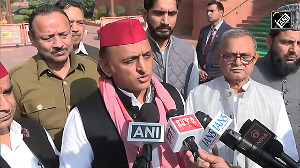The ongoing general elections are the first to be contested under the newly delimited constituency framework. Some recent state elections were conducted within the new arrangements and there is a view that they do have an impact on the outcome. Whether this is true at a national level or not will undoubtedly be revealed by micro-analysis of voting numbers after the election results are in. But, there are several larger issues relating to the concept and principles of delimitation itself.
Quite obviously, the fundamental objective of delimitation is to ensure that there is equitable representation across different, geographically defined population segments.
The principle of "one-person, one vote" may be the essence of modern democracy, but there are several ways of translating this into representative structures. Geographic constituencies are only one of several, but their prevalence across the world is presumably based on their perceived superiority over other modes of representation.
In a geographic constituency framework, two basic principles need to be applied. One, the number of people represented by each member of the legislature must be roughly equal. Two, the "interests" of each constituency must be relatively homogeneous.
Violation of the first leads to horizontal imbalance: some parts of the country exercising undue influence over the legislative process. Violation of the second results in vertical imbalance: in a heterogeneous constituency, the interests of one group dominate those of the others.
Obviously, no perfect solution exists; different countries have found different ways to align their legislative systems with these two principles. The US, for example, offsets horizontal capture by equal representation for all states in the Senate, which has enormous powers. The UK deals with vertical capture by having relatively small and homogeneous constituencies. The House of Commons has 635 members representing about a 100 million people, while the Lok Sabha has 543 members representing over 10 times that number.
Viewed from this perspective, the Indian model of representation has some rather significant weaknesses. While we can take great pride in the robustness and integrity of the electoral process itself, there are legitimate concerns about whether the process is delivering outcomes that are consistent with the objective of both horizontal and vertical balance.
The recent delimitation exercise was done under some significant numerical constraints. First, there is the issue of the number of seats in the Lok Sabha and the state legislative assemblies. The first Lok Sabha had 489 seats, representing about 360 million people. The number of seats was raised to 518 in 1971 and then to 542 in 1977.
The last increase was in 1989, to 543, where it stands today. This is a mere 11 per cent increase over a span of time in which the population has trebled. Similarly, the number of seats in state assemblies has remained relatively static.
Let's look at the distribution of Lok Sabha seats across states. To illustrate, if the 543 seats were allocated among states based on their proportion of the population, Uttar Pradesh would gain 8 seats from its current 80, while Tamil Nadu would lose 6 from its current 39.
Of course, by this rule, many of the smaller states and Union Territories may not be eligible for even one seat, but the larger point is that a state like Tamil Nadu which, going by the numbers, has had considerable success in controlling its population, would be penalised.
It is not surprising that Tamil Nadu was the most ardent advocate of freezing the number of Lok Sabha seats for each state.
Going strictly by the equity criterion, this gives the state the second highest Representation Ratio (share of seats / share of population) in the country -- 1.18. The highest, 1.19, belongs to Kerala, the other paragon of effective population policies. At the lower end are Uttar Pradesh and Madhya Pradesh, both with a ratio of 0.91, but the lowest ratio of 0.90 belongs to Haryana.
One could argue with some legitimacy that the difference in this parameter across states is not terribly significant given the population numbers involved. The current allocation thus balances the conflict between equitable representation and incentives for effective population policies, a principle that has also been built into other federal mechanisms like the Finance Commissions.
But, the question of horizontal capture still remains. Even with the current distribution of seats, given the inherent inequality in the size of states, are the interests of particular geographic constituencies unduly influencing the legislative process and, by extension, the entire system of governance?
Let's look at the issue of vertical balance. Given that the average size of a Lok Sabha constituency is over 2 million people (with significant variation), homogeneity of interests is a distant, even impossible, dream. One useful, though incomplete, measure of homogeneity is the distribution of the population between rural and urban areas, each reflecting a different set of interests.
The recently completed delimitation exercise has directly addressed this issue.
Constituency boundaries have been redrawn within states, affecting both assembly and Lok Sabha constituencies.
Going by reports, as a result of this, about 40 per cent of the latter have significant urban populations. This reflects the steady transition of people from rural to urban jurisdictions. For the country as a whole, the share of the urban population increased from 20 per cent to 28 per cent between 1971 and 2001. In states like Maharashtra and Tamil Nadu, the share of the urban population is now in excess of 40 per cent.
The impact of the delimitation in this context will be far more significant in state assembly elections, as smaller constituencies allow for greater homogeneity. In the redrawn Lok Sabha constituencies, the heterogeneity may yet be too large for the elected member to balance between the different needs of the two groups.
Even as urban populations grow, if the new boundaries are going to be in place for a long time, vertical balance at the Lok Sabha level is some distance away.
To sum up, delimitation is an integral part of the drive to achieve effective representation and governance in a democracy. The fewer the constraints it operates within, the more it will be able to contribute to this objective. In India, while the issue of vertical balance has partially been achieved, horizontal balance still poses many challenges. Some combination of increasing the number of seats and tweaking the allocation across states needs to be considered.
The author is Chief Economist, Standard & Poor's Asia-Pacific. Views are personal






